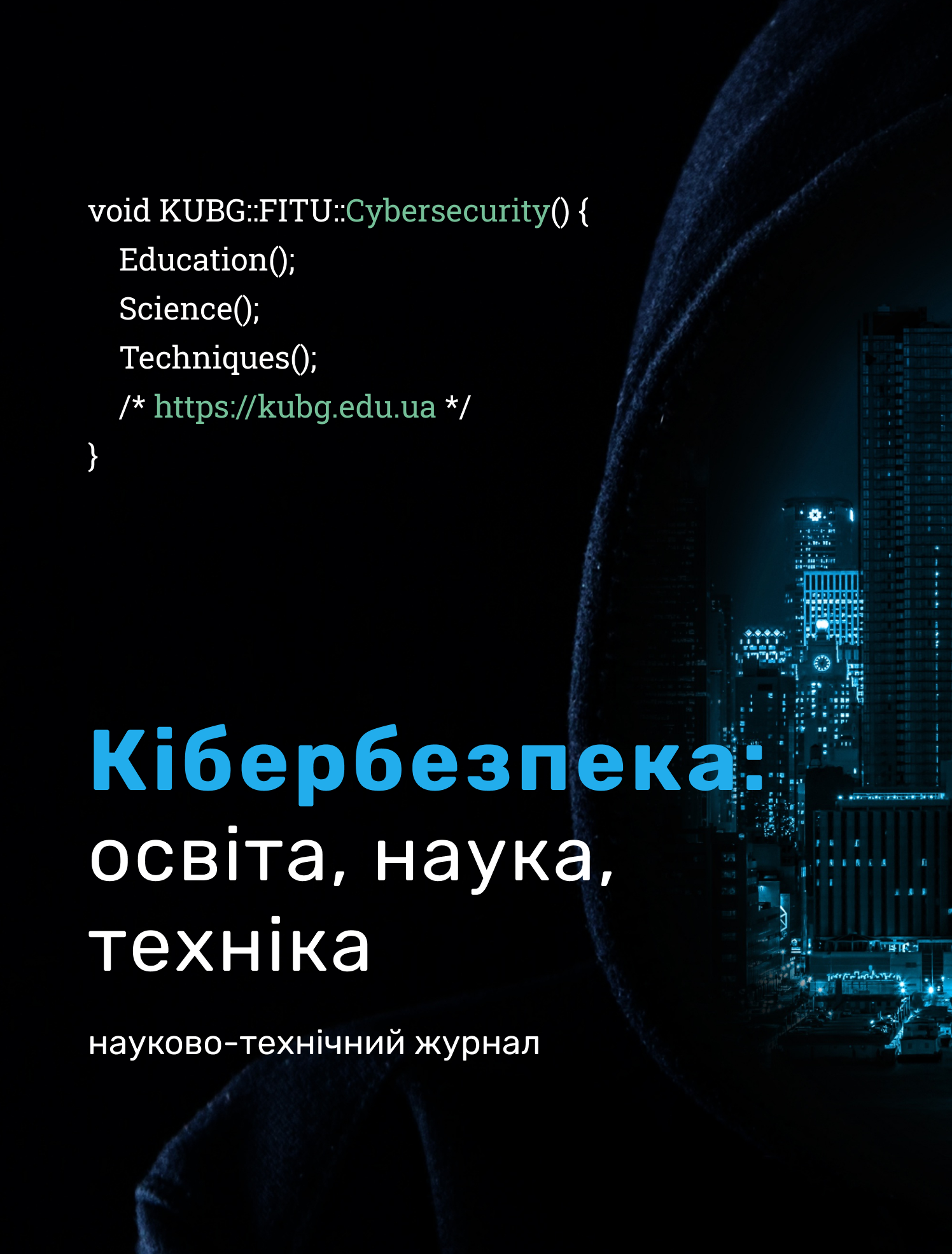MODIFICATION OF THE CRYPTOGRAPHIC ALGORITHM A5/1 TO ENSURE COMMUNICATION FOR IOT DEVICES
DOI:
https://doi.org/10.28925/2663-4023.2023.20.253271Keywords:
: Internet of Things; cryptographic protection; A5/1; devices with limited computational resources; encryption algorithms; efficiency; confidentiality; threat model.Abstract
Internet of Things (IoT) networks exhibit high diversification due to the significant number of devices with varying characteristics, operating systems, protection algorithms, and information transmission protocols. Cryptographic algorithms, however, cannot perform equally well on different devices; most of them demonstrate low encryption speed and high memory requirements on 8-bit C0-class devices. This article explores the modification of the cryptographic algorithm A5/1 for application in IoT networks with 8-bit devices with limited computational resources. A threat model is formulated, identifying major threats and possible methods for neutralization, including cryptographic protection methods. Through the developed modification, the main drawbacks of A5/1 when applied to protect information in IoT networks have been addressed, including increasing the key length, enhancing tamper resistance, and optimizing for use on 8-bit devices. Proposed substitutions of bit data processing with byte processing have improved cryptographic qualities and made algorithm application more convenient on devices with limited computational resources. Based on statistical tests, the encrypted sequence can be considered uniformly distributed at random. For the application of the modified algorithm, a cryptographic protocol was constructed, incorporating methods for device identification and secure key management. The proposed solutions were practically implemented and tested, achieving acceptable encryption speed for many applications on an 8-bit device.
Downloads
References
Rahman, M. S., Karnik, S., & Sarangerel, S. (2022). Lightweight Cryptography. MIT Course Project. Retrieved from https://courses.csail.mit.edu/6.857/2022/projects/Shahir-Rahman-Karnik-Sarangerel.pdf
Pradhan, D., & Tun, H. (2022). Security Challenges: M2M Communication in IoT. Journal of Electrical Engineering and Automation, 4, 187-199. https://doi.org/10.36548/jeea.2022.3.006
Mhaibes, H. I., Abood, M. H., & Farhan, A. (2022). Simple Lightweight Cryptographic Algorithm to Secure Embedded IoT Devices. International Journal of Interactive Mobile Technologies (iJIM), 16(20), 98–113. https://doi.org/10.3991/ijim.v16i20.34505
Al-Shargabi, B., & Dar Assi, A. (2023). A modified lightweight DNA-based cryptography method for Internet of Things devices. Expert Systems, 40(6), e13270. https://doi.org/10.1111/exsy.13270
Final report of European project number IST-1999-12324, named New European Schemes for Signatures, Integrity, and Encryption. Springer-Verlag, Berlin Heidelberg NewYork, etc. 2004, NESSIE public report D20. NESSIE Security Report. http://cryptonessie.org.
Daemen, J. Rijmen V. (1998) "AES Proposal: Rijndael," AES Round 1 Technical Evaluation CD1: Documentation, National Institute of Standards and Technology, Aug 1998. http://www.nist.gov/aes.
Horbenko I. D., Horbenko Yu. I. (2012) Applied Cryptology: monograph. – Kharkiv, KhNURE, Fort, 2012. – 868 p.
Kuznetsov O. O. et al. (2014) Substantiation of requirements, construction, and analysis of promising symmetric cryptographic transformations based on block ciphers. URL: https://science.lpnu.ua/sites/default/files/journal-paper/2017/nov/6634/21-124-141.pdf
Buhantsov A.D., Sadjiid A.Yu., Ustinov A.N., Rodionov C.V. (2021) Research of speech encryption reliability in GSM mobile communication technology. Research result. Information technologies. – vol.6, №2, 2021. P. 9-17. DOI: 10.18413/2518-1092-2021-6-2-0-2
Xu, Y., Hao, Y., & Wang, M. (2023). Revisit two memoryless state‐recovery cryptanalysis methods on A5/1. IET Information Security, 17. https://doi.org/10.1049/ise2.12120.
Glukhov M., Elizarov V., Nechaev A. (2003) Algebra, vol. 2, Gelios APB, 2003. 416 p. ISBN8-85338-072-2
Buryachok V. L., Gulak G.M., Skladannyy P. M. (2017) Fast algorithm for generating substitutions of a multialphabetic substitution. Information security. 2017. №2. P. 173–177.
Gulak G.M., Skladannyy P.M. (2017) Ensuring reliability of automated control and data transmission systems of unmanned aerial vehicles. Mathematical machines and systems. 2017. № 3. P. 154–161.
Shannon C. (1949) Communication Theory of Secrecy Systems / Bell System Technical J. 1949. vol. 28. P. 656–715.
Massey J.L., Maurer U., and Wang M. Non-Expanding (1988) Key-Minimal, Robustly-Perfect, Linear and Bilinear Ciphers. Adv. Cryptology EUROCRYPT’87. Berlin; Heidelberg: Springer Verlag, 1988. P. 237–247.
Gulak G., Kovalchuk L. (2001) Different approaches to defining random sequences / Legal, regulatory, and metrological support of the information protection system in Ukraine. – Kyiv, 2001. Issue 3. P.127–133.
Special publication NIST SP 800-22A (2010) Statistical Test Suite for Random and Pseudorandom Number Generators for Cryptographic Applications. URL: https://nvlpubs.nist.gov/nistpubs/legacy/sp/nistspecialpublication800-22r1a.pdf
Kristinsson, B. (2011). Ardrand: The Arduino as a Hardware Random-Number Generator. Retrieved from https://api.semanticscholar.org/CorpusID:195592641
J. Hoffstein, J. Pipher, J.H. Silverman. (2014) An introduction to mathematical cryptography. – Springer. 2014. – 523 p. ISBN 978-1-4939-1711-2
Bessalov A.V. Elliptic curves in Edwards form and cryptography: monograph. – Kyiv: IVC "Publishing House "Polytechnika"", 2017. – 272 p.
DSTU 9041:2020 Information technologies. Cryptographic protection of information. Algorithm for encrypting short messages based on twisted Edwards elliptic curves (2020). Retrieved from: http://online.budstandart.com/ua/catalog/doc-page.html?id_doc=90523
Kulasekara, V., Balasooriya, S., Chandran, J., & Kavalchuk, I. Novel low-power NRF24L01 based wireless network design for autonomous robots. In 2019 25th Asia-Pacific Conference on Communications (APCC), 2019 (pp. 342-346): IEEE
A security mechanism for Enhanced ShockBurst wireless communication protocol using nRF24L01. https://doi.org/10.21203/rs.3.rs-3777984/v1
Rivera, D., García, A., Martín-Ruiz, M. L., Alarcos, B., Velasco, J. R., & Oliva, A. G. (2019). Secure communications and protected data for an Internet of Things smart toy platform. IEEE Internet of Things Journal, 6(2), 3785-3795.
Published
How to Cite
Issue
Section
License
Copyright (c) 2023 Віктор Корнієць, Роман Черненко

This work is licensed under a Creative Commons Attribution-NonCommercial-ShareAlike 4.0 International License.




